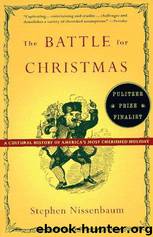The Battle for Christmas by Stephen Nissenbaum

Author:Stephen Nissenbaum
Language: eng
Format: mobi, epub
Tags: Christmas & Advent, Customs & Traditions, History, General, United States, Religion, Christmas - United States - History, Holidays, Christmas, Social Science
ISBN: 9780679740384
Publisher: Random House, Inc.
Published: 1997-10-28T10:00:00+00:00
?HE ISSUE came to a head at Christmas. Here was the one occasion on which even those parents who held to the more traditional idea of child-rearing tended to give up any real effort to maintain what Elizabeth Ellery Sedgwick called “the balance between restraint and indulgence.” Christmas had long been the kind of occasion on which restraint (of whatever sort) was momentarily suspended and indulgence ruled. In a different culture—a world of scarcity, with seasonal cycles of plenitude—the axis along which that shift took place was one that involved a brief period of gluttonous feasting or similar forms of revelry. In contrast, for genteel Unitarian families who inhabited a world of relative abundance, that axis involved a similarly brief period of undammed affection for their children, an affection made manifest in a lavish orgy of gift-giving.
Back in 1827, Charles Follen (then a newcomer to America) had a conversation with a friend “about the celebration of Christmas in Germany.” Follen lamented that there were “no feasts for the children” in the United States. “Such festivals for the feelings,” he mused, “would be a great improvement of the moral state of the nation.”53 As we know, even as Follen spoke, this kind of festival was becoming more widespread—1827 was the very year that Clement Clarke Moore’s poem “A Visit from St. Nicholas” was widely printed for the first time.
But even among those who, like Elizabeth Ellery Sedgwick, were ordinarily anxious about the dangers of such indulgence, Christmas functioned as a momentary release from that anxiety, a “festival for the feelings.” Mrs. Sedgwick herself offers a case in point. During the second half of 1835, she was deeply concerned about her oldest child, a 10-year-old boy named Ellery. Young Ellery had been placed in the trustworthy care of his Aunt Elizabeth (Elizabeth Dwight Sedgwick, the critic of Bronson Alcott and author of the aforementioned 1833 Christmas story), but he was showing worrisome signs of moral weakness. On one occasion he asked his mother to give him a silver pencil. (Characteristically, she refused, suggesting instead that he buy himself “a wooden one—learn to take care of it—and then you shall deserve a better kind of one, and shall have it.”) Far worse, his Aunt Elizabeth had caught him cheating systematically on his Latin homework and then lying about the matter when he was confronted with it. All that autumn, the boy’s parents carried on an intensive correspondence about how to handle the matter. Elizabeth Ellery Sedgwick endured sleepless nights on her son’s account. (“I am mortified and distressed, & fear I have been unfaithful to him, for these faults come back to the Mother.”) But at Christmas the parents’ pent-up anxiety was released in a torrent of affection, as both father and mother wrote letters assuring their errant son (still away at school with his aunt) of how intensely they missed him (“We miss you dreadfully dear Ell, every hour of the day”) and letting him know that they had actually set up a table filled with presents for him (“to show where he would be if he was here”).
Download
The Battle for Christmas by Stephen Nissenbaum.epub
The Battle for Christmas by Stephen Nissenbaum.epub
This site does not store any files on its server. We only index and link to content provided by other sites. Please contact the content providers to delete copyright contents if any and email us, we'll remove relevant links or contents immediately.
| Christmas | Easter & Lent |
The 5 Love Languages: The Secret to Love That Lasts by Gary Chapman(9588)
The Space Between by Michelle L. Teichman(6855)
Assassin’s Fate by Robin Hobb(6127)
Wiseguy by Nicholas Pileggi(5671)
Everything Happens for a Reason by Kate Bowler(4677)
Gerald's Game by Stephen King(4581)
Pillow Thoughts by Courtney Peppernell(4208)
A Simplified Life by Emily Ley(4098)
The Power of Positive Thinking by Norman Vincent Peale(4002)
Harry Potter and the Prisoner of Azkaban (Book 3) by J. K. Rowling(3304)
Resisting Happiness by Matthew Kelly(3301)
Being Aware of Being Aware by Rupert Spira(3229)
Girl, Wash Your Face by Rachel Hollis(3207)
The Code Book by Simon Singh(3074)
The Secret Power of Speaking God's Word by Joyce Meyer(2969)
Real Sex by Lauren F. Winner(2967)
More Language of Letting Go: 366 New Daily Meditations by Melody Beattie(2966)
Name Book, The: Over 10,000 Names--Their Meanings, Origins, and Spiritual Significance by Astoria Dorothy(2939)
The Holy Spirit by Billy Graham(2892)
